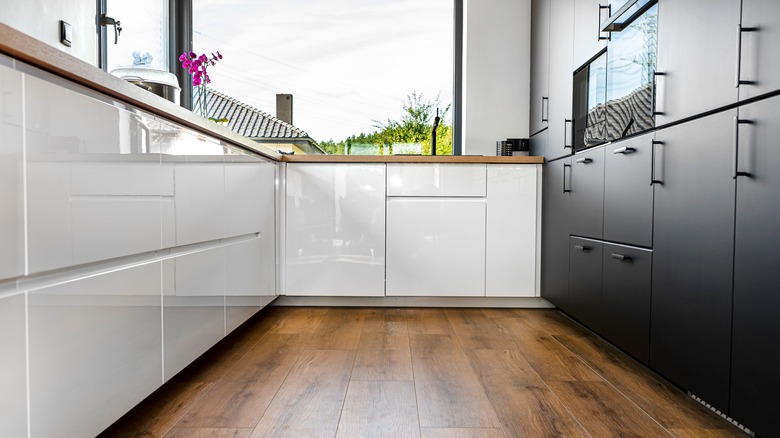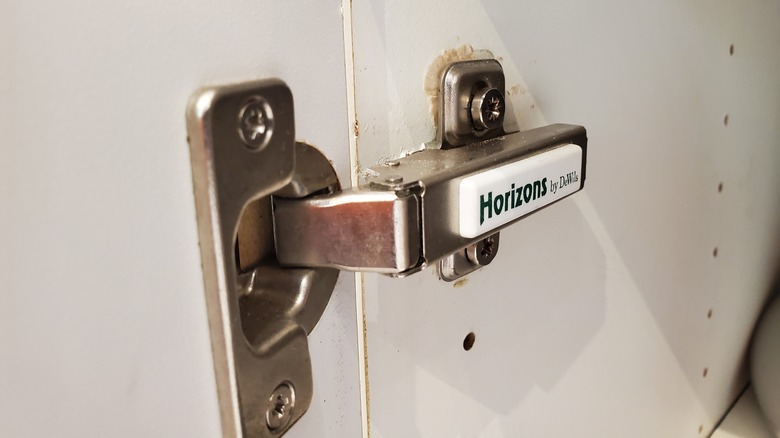What Are Frameless Kitchen Cabinets And Are They Right For Your Home?
If you want to make a few savvy and stylish upgrades to your kitchen, you might want to consider frameless kitchen cabinets. Although the name hints at its basic concept, it's good to know they can also be called Euro-style cabinets due to their popularity in Europe. Boasting a sleek and almost simple design, these cabinets lack the framed section around the opening. The frame that stretches around 1½ inches beyond the doors is usually where the cabinet's hardware is affixed to hold the door in place. On frameless cabinets, the doors — which tend to be flat panels made of anything from metal, glass, or other materials — are attached by hinges directly to the inside of the cabinet wall.
Also known as modern and contemporary cabinets and full access cabinets, this is because they make getting whatever you need inside quick and convenient. Now a popular choice in places outside of Europe, it undoubtedly appeals to anyone who appreciates clean lines, chic styles, and a minimalistic aesthetic in their kitchen, not to mention those who need or want an abundance of space. Although this might make you want to run right out to pick up frameless cabinets for your kitchen, there are some important factors to consider before you opt for this particular style.
Frameless kitchen cabinets need TLC
Frameless kitchen cabinets may be a sleek choice, but that doesn't necessarily mean they're simple. In fact, they require certain TLC that you should know about before deciding to install them in your home. For instance, installing them tends to be rather finicky, which can be a hassle. Ensuring that your frameless cabinets fit properly is incredibly important, which means that precise measurements need to be taken, and the pieces have to be installed almost perfectly. Otherwise, you might end up with gaps between your cabinets. You might also not have enough room to fully open them.
Once the cabinets are in, you might still face issues like dealing with a relatively flimsy design. Although these cabinets aren't necessarily shoddy, the fact that they don't have a frame means that they don't have as much support. In turn, they aren't as strong or sturdy. This also means that they might not last as long as other options.
Beyond that, the hinges used to secure frameless cabinets can become loose or crooked. To keep this from becoming a major problem, you may need to adjust and fix the hardware regularly. If you don't, then your cabinets could become permanently damaged. This is an outcome you'd rather avoid, especially since frameless cabinets aren't cheap.
You might pay more for frameless kitchen cabinets
Despite not always being as sturdy or long-lasting as other choices, frameless kitchen cabinets are costly. Although they don't always use pricey materials or an expensive production process, they sometimes use a hardier material to give the cabinets the support they would have gotten from a frame. Beyond that, they are also popular. Because of this, there's a high demand for the product which can drive up the price.
For a little context, in a kitchen that's around 10x10 feet, frameless kitchen cabinets will generally cost $1,000 more than the framed versions. Of course, you'll undoubtedly pay more if you have a larger kitchen, need a lot of cabinet space, or want cabinets offering bonus features and potential accents. On the other hand, there are some relatively affordable options at stores that mass-produce their items.
Before you choose your new cabinets, you'll need to do a little research to figure out what kind of frameless kitchen cabinets you want, how much they'll cost to purchase and install, as well as how much money, time, and energy you'll spend keeping them both looking good and working well. To ensure that your cabinet upgrade will be a project you can afford, consider how many cabinets you need and what kind of design suits your space. From there, you can track down options that fit that criteria and your budget.


